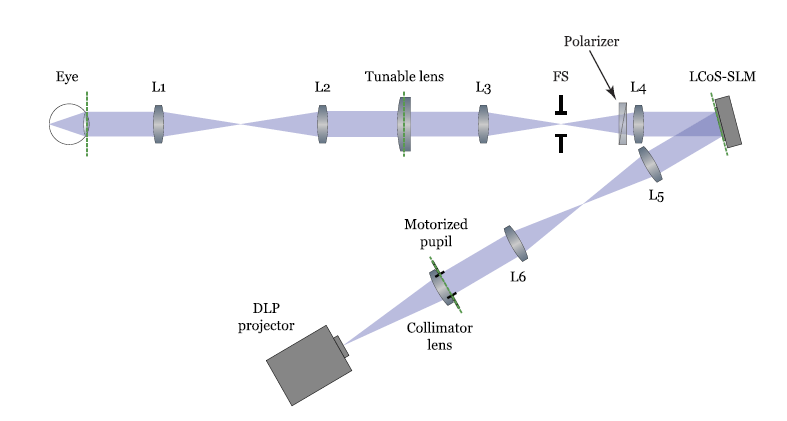Abstract: An enhanced adaptive optics visual simulator (AOVS) was used to study the impact of chromatic aberration on vision. In particular, through-focus visual acuity (VA) was measured in four subjects under three longitudinal chromatic aberration (LCA) conditions: natural LCA, compensated LCA and doubled LCA. Ray-tracing simulations using a chromatic eye model were also performed for a better understanding of experimental results. Simulations predicted the optical quality of the retinal images and VA by applying a semi-empirical formula. Experimental and ray tracing results showed a significant agreement in the natural LCA case (R2 = 0.92). Modifying the LCA caused an impairment in the predictability of the results, with decreasing correlations between experiment and simulations (compensated LCA, R2 = 0.84; doubled LCA, R2 = 0.59). VA under modified LCA was systematically overestimated by the model around the best focus position. The results provided useful information on how LCA manipulation affects the depth of focus. Decreased capability of the model to predict VA in modified LCA conditions suggests that neural adaptation may play a role.
Buscar
Categorías
Archivos
- diciembre 2025 (2)
- octubre 2025 (7)
- junio 2025 (2)
- mayo 2025 (1)
- marzo 2025 (4)
- diciembre 2024 (4)
- octubre 2024 (5)
- septiembre 2024 (1)
- julio 2024 (8)
- junio 2024 (1)
- mayo 2024 (1)
- marzo 2024 (1)
- octubre 2023 (2)
- julio 2023 (5)
- junio 2023 (1)
- julio 2022 (10)
- mayo 2022 (1)
- marzo 2022 (1)
- julio 2021 (5)
- marzo 2021 (2)
- octubre 2020 (36)
- septiembre 2020 (122)
- agosto 2020 (10)
- julio 2020 (38)
- abril 2020 (1)
- diciembre 2019 (1)
- abril 2018 (1)
- septiembre 2017 (2)

Impact of longitudinal chromatic aberration on through-focus visual acuity
- Voptica
- Publicaciones de VAO
Journal:
Optics Express
Year:
2019
Link:
Authors:
Nikolai Suchkov, Enrique J. Fernández, Pablo Artal